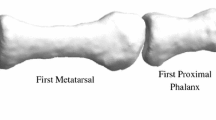Abstract
Many mathematical techniques have been developed to determine the geometry of articular joint surfaces, because of its so importance to the study of human joint biomechanics. However, a three-dimensional geometric model of the articular joint, which is essential to solid modelling, contact area measurement, and load bearing analyses, has not been well developed. This study proposes to define the articular geometry of the distal femoral joint of the human knee. A mathematical method based on the influence surface theory of plates is established to generate representations of three-dimensional articular surfaces. A mathematical cone and the surface of the human distal femur are accurately recreated, allowing their geometric properties to be determined. Results suggest that this method can be an effective tool for representing articular surfaces.
Similar content being viewed by others
References
Blankevoort L. and Huiskes R., 1986, “Selected Proceedings of the Fifth Meeting of the European Society of Biomechanics,” September 8–10, Berlin, F. R. G.
Blankevoort, L., Kuiper, J. H., Huiskes, R. and Grootenboer H., 1991,J. Biomechanics 24(11), 1019–1031.
Colbaugh, R., Glass, K., Ryu, J., 1991, Int. J. of Modeling and Simulation, 11, No. 3, 93–103.
Erkman M. J. and Walker P. S., 1974,J. Biomech Engng 9, 14–17.
Garg A. and Walker P. S., 1990, J. Biomechanics 23(1), 45–58.
Huiskes, R., Kremers, J., et al., 1985,J. Biomechanics 18(8), 559–570.
Kurosawa H., Walker P. S., Abe S., Garg A., and Hunter T., 1985,J. Biomechanics 18(7), 487–499.
Liewellyn J. A., Belsole R. J., Dale M. M., Hilbelink R. D., and Senzler S. A., 1989,IEEE Engineering in Medicine & Biology Society 11th Annual International Conference, 818–819. PV-WAVE Technical Reference Manual, August, 1990.
Rehder, U., 1993,J. Biomechanics 16(5), 351–361.
Ruan W., 1987, J. Tongji University, 15(4), 501–507.
Scherrer P. K. and Hillberry B. M., 1979,J. Biomechanics 12, 301–311.
Shiba, R., Sorbie C., Siu D. W., Bryant J. T., Cooke T. D. V., and Wevers H. W., 1988, J. Orthop Res 6, 897–906.
Szilard R., 1974, Prenticehall, INC., Englewood Cliffs, New Jersey.
Wylie C. R. and Barrett L. C. 1982. McGraw-Hill International Book Company.
Author information
Authors and Affiliations
Rights and permissions
About this article
Cite this article
Han, J.S., Han, H.S. Mathematical representation of articular surfaces using influence surface theory. KSME International Journal 12, 380–387 (1998). https://doi.org/10.1007/BF02946352
Received:
Issue Date:
DOI: https://doi.org/10.1007/BF02946352




